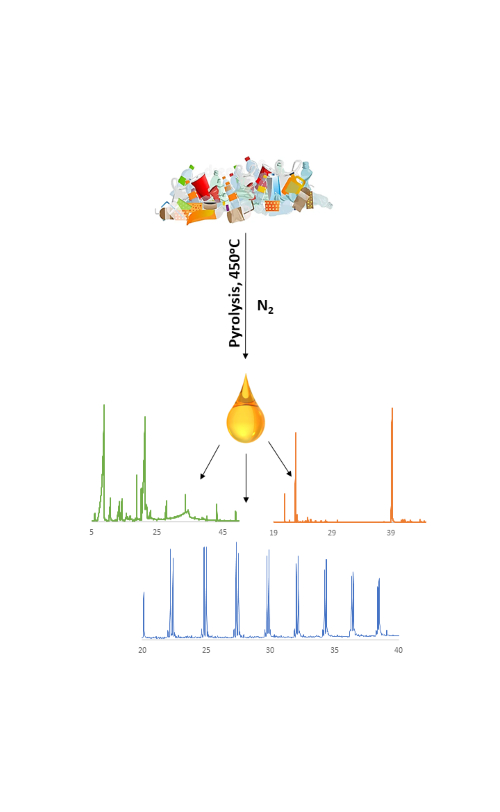Co-pyrolysis of various plastic waste components as an environmentally sustainable source of alternative fuels Scientific paper
Main Article Content
Abstract
In this study, pyrolysis and co-pyrolysis of commonly used plastic materials (polyethylene terephthalate – PET, high density polyethylene – HDPE, and polystyrene – PS) were conducted to analyse the chemical composition of the corresponding pyrolyzates. Different ratios of plastic materials were applied to obtain a composition of aliphatic and aromatic degradation products that closely resemble those of conventional fossil fuels. The systematic chemical variations can act as base for evaluating this approach as a sustainable source of alternative fuels. HDPE revealed an aliphatic composition of degradation products, while PS and PET produced only aromatic compounds. Quantitative analysis of the obtained pyrolyzates revealed a clear correlation of initial proportion with the resulting quantitative product composition. The generation of individual pyrolysis products gave a high reproducibility. However, it became evident that the decomposition products of PS consistently emerged as the most prominent among all tested HDPE/PS mixtures. The ratio of HDPE:PS = 1:3 showed 96 % of the aromatic compounds as PS decomposition products. PET revealed a oxygen containing structure of the products, contributing to 83 % of the HDPE:PET = 1:3 mixture. These results gain insights into the potential of plastic waste as a sustainable source for alternative fuels and valuable chemicals.
Downloads
Metrics
Article Details

This work is licensed under a Creative Commons Attribution 4.0 International License.

Authors retain copyright and grant the journal right of first publication with the work simultaneously licensed under a Creative Commons Attribution license 4.0 that allows others to share the work with an acknowledgement of the work's authorship and initial publication in this journal.
Funding data
-
Bundesministerium für Bildung und Forschung
Grant numbers xxx
References
https://www.eea.europa.eu/publications/many-eu-member-states/germany
L. Dai, N. Zhou, Y. Lv, Y. Cheng, R. Ruan, Y. Liu, K. Cobb, P. Chen, H. Lei, R. Ruan, Progr. Energy Combust. Sci. 93 (2022) 101021 (https://doi.org/10.1016/j.pecs.2022.101021)
J. Scheirs, W. Kaminsky, Feedstock recycling and pyrolysis of waste plastics: Converting waste plastics into Diesel and other fuels, Wiley Pol. Sci., 2006 (ISBN: 0-470-02152-7)
M. Rehan, A.-S. Nizami, K. Shahzad, O. K. M. Ouda, I. M. I. Ismail, T. Almeelbi, T. Iqbal, A. Demirbaş, En. Source, A 38 (2016) 2598 (https://doi.org/10.1080/15567036.2016.1153753)
D. S. Achilias, C. Roupakias, P. Megalokonomos, A. A. Lappas, E. V. Antonakou, J. Hazard. Mater. 149 (2007) 536 (https://doi.org/10.1016/j.jhazmat.2007.06.076)
P. Rutkowski, A. Kubacki, En. Con. Managе. 47(6) (2006) 716 (https://doi.org/10.1016/j.enconman.2005.05.017)
M. Brebu, S. Uçar, C. Vasile, J. Yanık, Fuel 89 (2010) 1911 (https://doi.org/10.1016/j.fuel.2010.01.029)
B. B. Uzoejinwa, X. He, S. Wang, A. E. Abomohra, Y. Hu, Q. Wang, En. Con. Managе. 163 (2018) 468 (https://doi.org/10.1016/j.enconman.2018.02.004)
J. A. Onwudili, N. Insura, P. T. Williams, J. Anal. Appl. Pyrolysis 86(2) (2009) 293 (https://doi.org/10.1016/j.jaap.2009.07.008)
R. U. Henneberg, R. P. Nielsen, M. E. Simonsen, J. Anal. Appl. Pyrolysis 173 (2023) 106037 (https://doi.org/10.1016/j.jaap.2023.106037)
E. A. Williams, P. T. Williams, J. Anal. Appl. Pyrolysis 40–41 (1997) 347 (https://doi.org/10.1016/s0165-2370(97)00048-x)
E. Dziwiński, J. Iłowska, J. Gniady, Pol. Test. 65 (2018) 111 (https://doi.org/10.1016/j.polymertesting.2017.11.009)
J. Choi, F. Jitsunari, F. Asakawa, D. S. Lee, Food Addit. Contam. 22(7) (2005) 693 (https://doi.org/10.1080/02652030500160050)
R. Pfaendner, Pol. Deg. Stab. 91 (2006) 2249 (https://doi.org/10.1016/j.polymdegradstab.2005.10.017)
S. Al-Malaika, F. H. Axtell, R. Rothon, M. Gilbert, in Brydson’s Plastics Materials, VIII ed., M. Gilbert, Ed., Elsevier, Amsterdam, 2017, pp. 127 (https://doi.org/10.1016/b978-0-323-35824-8.00007-4)
X. Ren, R. Chang, Y. Huang, A. A. Amato, C. Carivenc, M. Grimaldi, Y. Kuo, P. Balaguer, W. Bourguet, B. Blumberg, Endocrinology 164 (2023) 1 (https://doi.org/10.1210/endocr/bqad021)
C. Apel, J. Tang, R. Ebinghaus, Env. Poll. 235 (2018) 85 (https://doi.org/10.1016/j.envpol.2017.12.051)
Material Safety Data Sheet, https://datasheets.scbt.com/sc-223762.pdf
Z. Wen, L. Fang, H. Zhang, Drug Deliv. 16(4) (2009) 214 (https://doi.org/10.1080/10717540902836715)
I. Y. R. Adamson, J. Weeks, Arch. Env. Health 27 (1973) 69 (https://doi.org/10.1080/00039896.1973.10666320)
C. A. Baldrich, Diesel characterization by high resolution mass spectrometry-gas chromatography, C.T.F Cienc. Tecnol. Futuro [online], vol. 1, n. 4, 1998, pp. 65 (ISSN 0122-5383)
S. C. Gad, Diesel fuel, in Encyclopedia of Toxicology, Elsevier eBooks, Amstrdam, 2005, pp. 19 (https://doi.org/10.1016/b0-12-369400-0/00320-3)
M. Huth, A. Heilos, in Modern Gas Turbine Systems, P. Jansohn, Ed., Woodhead Publishing Ltd., Sawston, 2013, pp. 635 (https://doi.org/10.1533/9780857096067.3.635)
Diesel fuel and exhaust emissions, (Environmental Health Criteria, 171), World Health Organization, Geneva, 1996 (ISBN 92-4-157171-3, https://www.inchem.org/documents/ehc/ehc/ehc171.htm)
C. Zhou, A. Farooq, L. Yang, A. M. Mebel, Prog. Energy Combust. Sci. 90 (2022) 100983 (https://doi.org/10.1016/j.pecs.2021.100983)
V V. L. Mangesh, S. Padmanabhan, P. Tamizhdurai, S. S. Narayanan, R. Arumugam, J. Hazard. Mater. 386 (2020) 121453 (https://doi.org/10.1016/j.jhazmat.2019.121453)
A. Çakıcı, J. Yanık, S. Uçar, T. Karayıldırım, H. Anıl, J. Mater. Cycles Waste Manage. 6 (2004) 20 (https://doi.org/10.1007/s10163-003-0101-y)
A A. R. Ardiyanti, С. А. Хромова, R. H. Venderbosch, V. А. Yakovlev, H. J. Heeres, Appl. Catal., B 117–118 (2012) 105 (https://doi.org/10.1016/j.apcatb.2011.12.032)
I. Hita, A. Gutiérrez, M. Olazar, J. Bilbao, J. M. Arandes, P. Castaño, Fuel 145 (2015) 158 (https://doi.org/10.1016/j.fuel.2014.12.055)
CONCAWE Review 11(2) (2002) 10 (https://www.concawe.eu/wp-content/uploads/cr112-aromatics-2003-01897-01-e.pdf)
M. J. DeWitt, E. Corporan, J. Graham, D. K. Minus, Energy Fuels 22 (2008) 2411 (https://doi.org/10.1021/ef8001179)
S. Sharma, P. Singh, C. Bhardwaj, B. Khandelwal, S. Kumar, Energy Fuels 35 (2021) 3150 (https://doi.org/10.1021/acs.energyfuels.0c03511)
E. B. Strel’nikova, I. V. Goncharov, О. В. Серебренникова, Pet. Chem. 52 (2012) 278 (https://doi.org/10.1134/S096554411204010X)
A. G. A. Jameel, Y. Han, O. Brignoli, S. Telalović, A. M. Elbaz, H. G. Im, W. L. Roberts, J. Anal. Appl. Pyrolysis 127 (2017) 183 (https://doi.org/10.1016/j.jaap.2017.08.008)
M. Z. H. Khan, M. Sultana, Md. R. Al-Mamun, Md. R. Hasan, J. Env. Pub. Health 2016 (2016) 7869080 (https://doi.org/10.1155/2016/7869080)
Wilke, S. (n.d.). Kunststoffabfälle. Umweltbundesamt (https://www.umweltbundesamt.de/daten/ressourcen-abfall/verwertung-entsorgung-ausgewaehlter-abfallarten/kunststoffabfaelle#kunststoffvielfalt).





